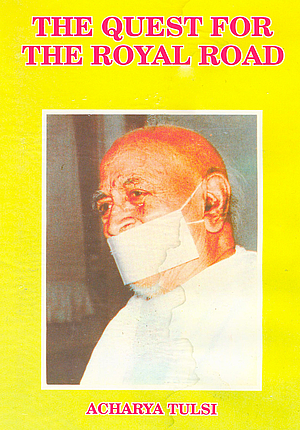In those days, the propagator of the tradition of Bhagwan Parshawa, Kumar Sraman Kesi was on pilgrimage. During his sojourns, he came to the city of Sravasti. He was accompanied by hundreds of sadhus. He camped at a park called Tinduk.
Bhagwan Mahavira's chief disciple, Ganadhara Gautama was also travelling in the areas around the city of Sravasti. He too arrived there with his group of disciples. He camped at a park called Koshtaka.
Sraman Kesi and Ganadhara Gautama were distinguished scholars. But among their disciples were the sadhus who were new entrants to the Order as well as those who had been in the order for long. They closely regarded each other and they had quite a few questions in their minds. They found the differences in dress, religious practices etc. quite irksome. They went to their acharyas and discussed about these differences. Both the acharyas decided to meet with a view to satisfy their disciples.
Gautama went with his disciples to the Tinduka park to meet Sramana Kesi who received them with due respect.
Thousands of people had gathered at the Tinduka that day.
Sramana Kesi asked innumerable questions to Gautama in the presence of all those people.
Gautama gave his answers. A very significant question among that chain of questions was, "There are so many undesirable paths in this world and people following those paths lose their direction. Gautama, how is it that you do not lose your way in spite of following that path?"
Gautama's answer was: "I am conscious about all those who follow those paths and those who follow the higher path.
That is why, oh Muni, I do not stray."[1]
This conversation between Sraman Kesi and Gautama shows that man should know which is the path that would lead men to their destination and which path would lead them astray. He who realises this, never treads a wrong path. The Quest for the Royal Path has been compiled only with this purpose in mind. It contains 61 articles and discourses of Acharya Shri Tulsi, who is devoted to the philosophy of anuvrat. Subjectwise, it has been divided into four sections. In the first section, there are 13 articles relating to Bhagwan Mahavira's life and his philosophy. The second section, contains discussion about non-violence and Mahatma Gandhi. In the third section, there is a free analysis of life-values. The fourth section, includes the individuals who are desirous to learn, i.e., questions and answers. On the whole, this is a book that can give a new direction to a person: The readers would have seen in it the possibility of new directions opening in their lives. That could be the only reason why first edition of the book was out of print very soon.
What is more noteworthy even than this, is the fact that the Jain Vishwa Bharati and the Adarsh Sahitya Sangh displayed hundreds of their publications at the World Book Fair in New Delhi in 1988. Millions of other books of all kinds were also exhibited at the Fair. After the Fair ended, a list of a few selected titles of the books exhibited was published in which only one title from the publications of these two organisations was included and it was Rajpath ki Khoj. This possibly led to an increased demand for this book and the second edition was brought out just within a year of its first publication.
The second and the third editions too were out of stock in no time. There was an unexpected delay in bringing out the fourth edition. Among a number of books by Gurudev Tulsi, which are being reprinted, following the public demand, the fourth edition is now presented. It is certain that the readers would find a new light by reading it.
India is described as a country given to spiritualism. What would the present generation of this country give to the future generation? Good character or corruption? Smile or tension? Discipline or permissiveness? If this generation wishes to leave behind good character, smile and discipline, then it will have to struggle against many weaknesses underlying the present- day life. An extremely sharp weapon to carry on this struggle is literature. Inspite of bearing the responsibilities of administration, study, teaching, giving discourses, public relations, etc., the literary current continuously flows in Acharya Tulsi's life and I very humbly aspire to have a dip in it.
Sadhvi Pramukha Kanak Prabha
Rishabh Dwar,
Ladnu, 341306
 Acharya Tulsi
Acharya Tulsi
